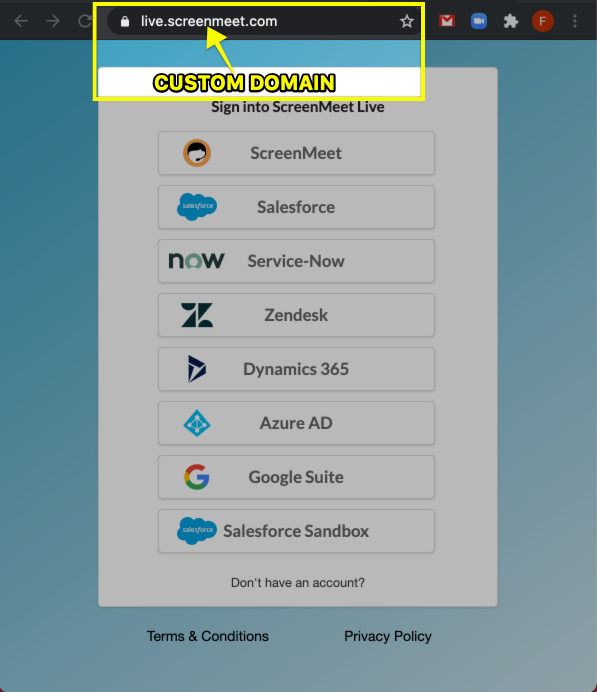Custom Domain
- 18 Jun 2021
- 1 Minuto para leer
- Impresión
- OscuroLigero
- PDF
Custom Domain
- Actualizado en 18 Jun 2021
- 1 Minuto para leer
- Impresión
- OscuroLigero
- PDF
The content is currently unavailable in Spanish. You are viewing the default English version.
Resumen del artículo
¿Te ha resultado útil este resumen?
Gracias por sus comentarios
ScreenMeet Live Domain Customization Options
This is an additional ScreenMeet service, please contact us at support@screenmeet.com for pricing and to setup your custom domain.

There are a 2 options available in order to setup a custom domain:
1) Using a URL with a custom subdomain and screenmeet.com top-level-domain.
With this approach, we could use URL's such as <custom>.screenmeet.com - eg, customdomain.screenmeet.com
This option is the easiest and would require no additional effort from you.
2) Using a fully custom URL
With this approach, we could use any URL. eg: meet.customdomain.com or similar.
There are a few possible technical implementation paths here:
- Your organization could set up a proxy at a URL of their choice and use https://live.screenmeet.com as the origin. Proxy should be configured to forward querystrings / headers / etc.
- Your organization could set up DNS CNAME entries to point at a CDN end-point provided by screenmeet. In this case, we would also have to set up an SSL certificate, for which we also have several options:
- ScreenMeet could use AWS ACM to provision the SSL certificate for the desired hostname (eg, meet.customdomain.com). In this case, there would be a total of 2 CNAME entries required, one for the actual hostname, and another for SSL certificate validation, which would look something like this: _a79865eb4cd1a6ab990a457
79b4e0b96.customdomain.com . With this approach, ScreenMeet could manage renewals of this certificate automatically as it expires annually / bi-annually. If someone were to click the certificate info in their browser it would show that the certificate is issued by Amazon. - Your organization could provide an SSL certificate they provision themselves to ScreenMeet, which we could import into our CDN. This would require bi-annual maintenance/updates as all SSL certificates have a maximum lifetime of 2 years.
- ScreenMeet could use AWS ACM to provision the SSL certificate for the desired hostname (eg, meet.customdomain.com). In this case, there would be a total of 2 CNAME entries required, one for the actual hostname, and another for SSL certificate validation, which would look something like this: _a79865eb4cd1a6ab990a457
¿Te ha sido útil este artículo?
.png)
